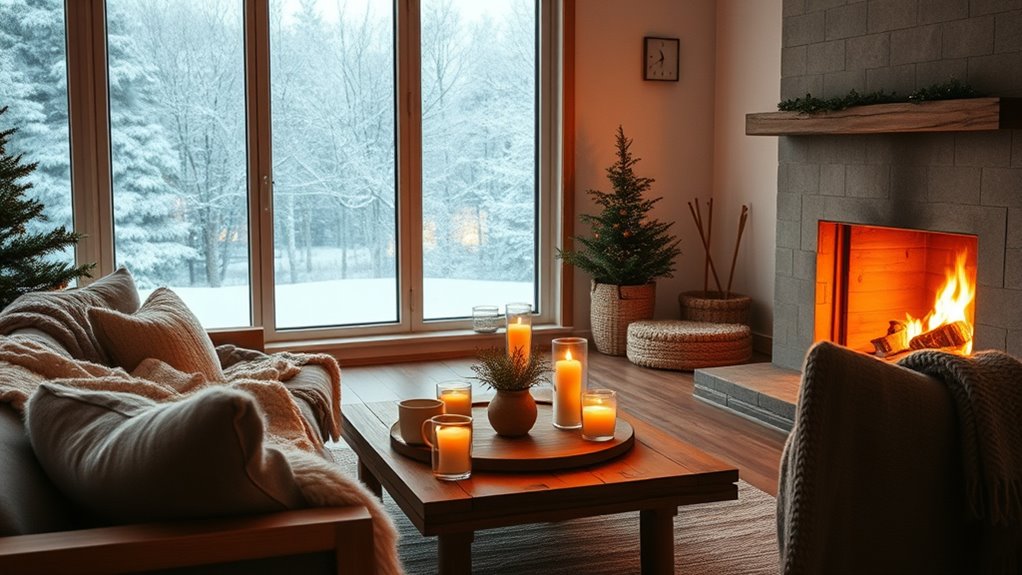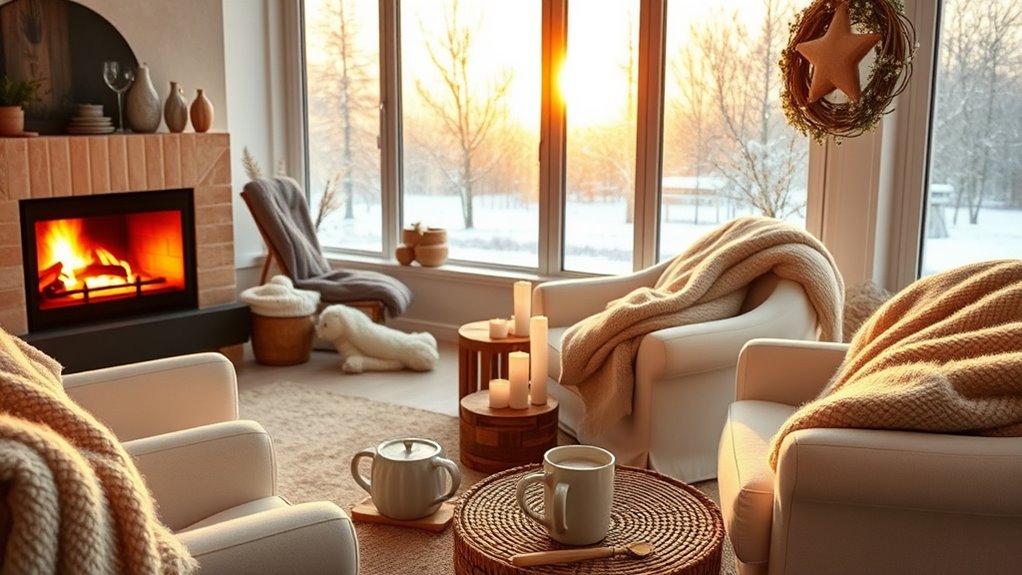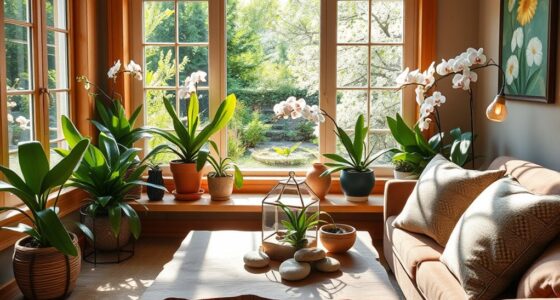Hygge is grounded in psychological science showing that creating cozy environments and engaging your senses boost happiness and reduce stress. Using warm lighting, soft textures, and familiar objects triggers your brain’s reward system, promoting feelings of safety and calm. Small, intentional comforts can transform any space into your personal sanctuary of well-being. By understanding these principles, you can craft your own cozy haven anywhere—if you keep exploring, you’ll discover how to make hygge part of your daily life.
Key Takeaways
- Hygge activates the brain’s reward system, promoting feelings of safety, relaxation, and happiness through cozy environments.
- Warm lighting, soft textures, and familiar objects trigger mood-boosting chemicals like serotonin and endorphins.
- Sensory engagement, such as tactile textures and soothing lighting, reinforces emotional stability and reduces stress.
- Creating cozy environments taps into psychological principles that nurture mental health and foster contentment anywhere.
- Simple adjustments like adding tactile objects or dim lighting can easily cultivate hygge-like comfort in any space.

Hygge, the Danish concept of cozy contentment, has gained worldwide popularity for its focus on comfort and well-being. But beyond its charming image, hygge taps into deep psychological and environmental principles that foster a sense of coziness and happiness. At its core, coziness psychology explores how small, intentional comforts can profoundly boost your mood and reduce stress. When you create an environment that emphasizes warmth, softness, and familiarity, you’re activating your brain’s reward system, encouraging feelings of safety and relaxation. This isn’t just about aesthetics; it’s about designing an environment that nurtures your mental health. Environmental comfort plays an essential role here. When your surroundings are cozy—think warm lighting, plush textures, and soothing colors—you signal to your brain that it’s okay to unwind. These elements trigger the release of mood-enhancing chemicals like serotonin and endorphins, reinforcing positive feelings. It’s a simple, science-backed way to elevate your everyday experience, regardless of where you are.
You might not realize it, but small adjustments to your environment can make a substantial difference in how cozy you feel. For example, swapping harsh overhead lighting for soft, warm lamps creates an inviting ambiance. Adding tactile elements like a chunky knit blanket or plush cushions can make your space more comforting. The goal is to craft a setting that invites you to slow down and enjoy the moment. This is where coziness psychology becomes practical—you’re actively engaging your senses to promote mental well-being. When you surround yourself with familiar, comforting objects, you reinforce feelings of security and stability, helping to combat stress and anxiety. This sense of environmental comfort isn’t just about physical warmth; it’s about creating a mental space where you feel grounded and cared for.
Getting hygge right means understanding that coziness is a holistic experience—it’s the interplay of sensory stimuli and emotional state. You don’t need a Scandinavian winter to enjoy it. Instead, focus on cultivating a cozy environment that feels right for you. Light candles or dim the lights to soften the atmosphere. Use textures that invite touch and comfort. Engage your senses intentionally, knowing that these simple acts can boost your mood and make your surroundings feel more nurturing. Ultimately, hygge is about more than aesthetics; it’s a science of coziness psychology and environmental comfort that you can harness anywhere to create your own sanctuary of well-being.
Frequently Asked Questions
Can Hygge Be Practiced in Small Apartments?
Yes, you can definitely practice hygge in a small space. Focus on cozy design by adding soft blankets, warm lighting, and personal touches that make your environment inviting. Declutter to create a calm atmosphere, and incorporate comfortable furniture to encourage relaxation. Even in limited space, small details like scented candles or a favorite mug can enhance your sense of comfort and coziness, making your apartment feel warm and hyggeligt.
How Does Hygge Affect Mental Health Long-Term?
Practicing hygge long-term boosts your mental health by enhancing mindfulness benefits, helping you stay present and reduce stress. It also builds emotional resilience, making you better equipped to handle life’s challenges. By creating cozy, nurturing environments, you develop a sense of safety and contentment. Over time, these habits foster greater happiness, lower anxiety, and a more positive outlook, contributing to sustained mental well-being in your everyday life.
Are There Cultural Differences in Hygge Practices?
Cultural variations shape how hygge is practiced, like different strokes for different folks. Regional influences influence your cozy rituals, making hygge uniquely yours based on where you live. In Denmark, it’s about simple comfort, while in Japan, it’s more about mindful presence. Recognizing these regional influences helps you adapt hygge to your culture, turning universal comfort into a personalized experience that truly resonates with your way of life.
Can Hygge Improve Relationships With Others?
Yes, embracing hygge can improve your relationships through cozy communication and emotional bonding. When you prioritize creating warm, inviting environments, you foster trust and openness with others. Sharing simple pleasures like candles or comfort food encourages meaningful conversations. These moments help deepen connections, making you feel more supported and understood. Practicing hygge regularly can strengthen your bonds, making your relationships more resilient and fulfilling.
What Are Common Mistakes When Trying to Create Hygge?
You might think creating hygge is simple, but common mistakes happen. For instance, cluttered spaces clash with cozy lighting, undermining comfort. Instead, focus on clutter reduction to foster calm and add warm, cozy lighting to set a relaxed mood. Avoid rushing the process; hygge takes time. Overdoing decorations or ignoring personal preferences can also backfire, so personalize your space with mindful touches that genuinely make you feel at ease.
Conclusion
Now, armed with the science behind hygge, you hold the secret to transforming any space into a sanctuary of unparalleled coziness and joy. Imagine turning your everyday moments into a symphony of warmth and contentment so powerful, it rivals the Northern Lights themselves. Embrace these simple yet profound changes, and you’ll discover a happiness so profound, it could make even the coldest Scandinavian winter seem like a warm embrace. The magic of hygge is yours to create—dare to indulge.








